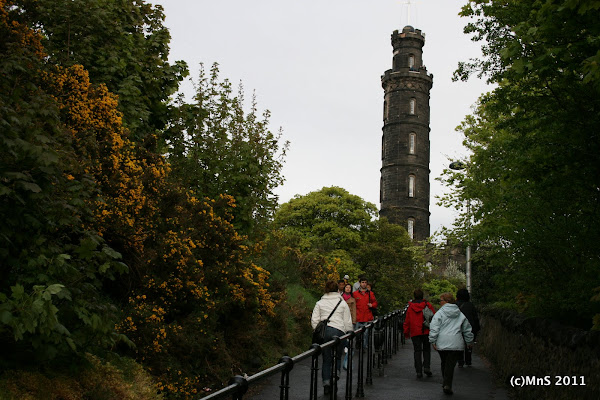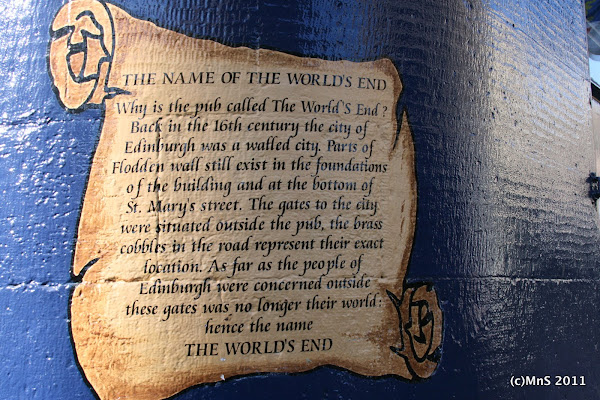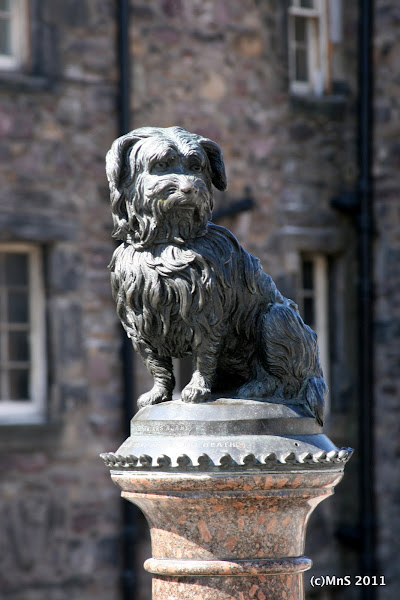It was late in the evening. We caught the bus from the airport and arrived to a mild drizzle and a chilly breeze. Well, rain is nothing out of the ordinary here as most of the locals would tell you.
Our hostel was in the middle of town, very conveniently located. Edinburgh is just as grey as London and every bit as beautiful. But they are sisters in contrast, the latter a sprawling metropolis, while Edinburgh, is much more friendly in terms of distances to the pedestrian. We could walk to our hearts content through the wet rainy streets, gusts of wind wrecking my newly acquired umbrella.
 |
| A cold rainy day in Edinburgh |
Our first day saw us walk the
Royal mile to Edinburgh castle
. One Scots mile long, this stretch is full of colour and history from street performers, to restaurants and pubs lining the streets, to offers of tours on ghosts and gauls, to narrow alleyways. Art and Literature converge and some of the greatest Scottish writers and Poets stand immortalized, in stone.
We reach the castle and check out options for tickets. We find ourselves a good deal, an explorer pass which allows us entry into a couple more castles along the way and valid for five days. For all else we are hoping the National Trust membership card proves handy and it sure did as we were to discover.
 |
| Exploring the Edinburgh Castle.. |
The Edinburgh castle is visible from a fair distance, silent watcher of the city and keeper of its secrets.
Having been in the center of much of Scottish history like the Scottish War of Independence and the Jacobite Raising, the castle is a beautifully preserved monument. From gorgeously lethal siege canons with very amusing names(Imagine being called
Mon's Meg), to pretty little chapels, stone structures and early prison systems, each section carries plaques telling the visitor where he or she is standing and its place in history. Somewhere in between I stand transfixed , seeing the exquisite stained glass paintings inside St Margaret's chapel, believed to be the oldest building inside the castle..
We walk and walk and finally head to the restaurant in search of steaming hot coffee.
 |
| Inside the Edinburgh castle.. |
When we finally leave its almost afternoon and we walk down into Princess gardens. Where this public space now stands was once
Nor Loch, a public drainage system, severely polluted. But in 1820 all that changed. The gardens are gorgeous, green and full of flowers, chilly from the morning rains. But we walk on. In a distance we
hear the pipers play. We walk in search of the source of the music and find ourselves in the Edinburgh's Ceilidh Culture Street Fair. The rains are unrelenting. We cancel old plans and make new ones...
 |
| The castle, with its magnificent gardens in the foreground.. |
The storm clouds clear and we have blue skies. We are walking up the road when we read signs and decide to take a detour. Off regent road , we briefly get lost before finding the stairs which would take us up to Carlton Hill. Nelson's monument (456 feet above sea level ) to commemorate Admiral Horatio Nelson who died serving his country in the Battle of Trafalgar(1805) dominates the skyline. It seems like the finish line standing tall and proud in the distance. All around its lush and green. It doesn't take too long for the stairs to give way to green grassy slopes.
 |
| Trekking up Carlton hill, Nelson's monument in a distance .. |
We sit a while. All around we can see the city, still wearing shades of grey and terribly moody and sullen from the rains.
 |
| The unfinished Acropolis - 'National Monument'.. |
Right on top we see the Acropolis, a beautiful unfinished structure set in stone. It looks everybit like its original,
'The Parthenon of the Acropolis' in Athens. Built as a tribute to those who lost their lives in the Napoleinic wars , its incompletion earned it the dubious nickname 'Nation's shame'. I think its beautiful. Stark against shades of green and yellow and with the blue sky in a distance, sunlight filtering through its many beams.
 |
| View of the city from Carlton hill.. |
We saunter back down unhurried, enjoying the views of the city spread out before us.
 |
| Scott Monument.. |
The Scott Monument, a steep flight of stairs to the heavens, is a beautiful structure in memory of Sir Walter Scott . It was 15 mins to closing time when we got there, so it turned out to be a race against time. The problem was we weren't the only ones in a hurry. From a distance I actually mistook the structure to be a church, its tall spire proudly held against the now blue sky. Mostly blackish, it is supposed to be of Victorian Gothic descent, the construction of which started in 1840 culminated four years later. It's architect who submitted the winning design in a competition to honour Sir Walter Scott, met a watery grave and therefore did not live to see its opening.
 |
| View from the top.. |
At some places the steps are so narrow, that traffic in both directions seemed impossible. We retreated to the balconies at each floor to decongest and allow people upstairs to walk down. At one point , I got too claustrophobic. We were one level below the top. But we ran out of time and heeding the call over the loudspeaker announcing closing time we climbed down.
 |
| 'The World's End,' Edinburgh has loads of pubs with names alluding to its history and literature .. |
The next day we are out early. Our destination is Hollyrood. Sadly its shut , because we hade chosen a public holiday for the visit :(. Again we change plans. We take on of the routes which directly take us up the famed Aurther's seat. The climb is beautiful. Again we get to see a different side of the city, Nelson's memorial stands tall in a distance. Its a good hike up. We snack a bit, and sit a while discussing history and politics, before deciding which route we woud take down. The hill some believe is the location of '
Camelot' , the home of King Auther and the Knights of the Roundtable.
 |
| From atop Auther's seat.. |
We head in the direction of the lake. We see specks of white. We would later discover that they are swans.
 |
| The lake on the other side of Auther's seat.. |
We walk round the late. We are famished. Our quest for a pub lunch is thwarted , as the clocks dont think its lunch time yet and most places arn't open. Finally we settle for something on the way.
 |
| A beautiful sunny day.. |
Edinburgh's food is among the best I've eaten. From the delicious cream teas in
Deacon House, to the exquisite Peshawari Naan of
Kebab Mahal, to the totally yummy hand backed Pizzas from
Mama's Pizza , we did not hold back when it came to the food. What was fascinating for me was that some of these places were allusions to Edinburgh's rich literary and historic past. Sitting in Deacon house we uncover the legend behind Dr Jekyll and Hyde; Broody was an exemplary citizen by day , even serving public offices , but was a burglar by night. He finally was sentenced to death and where his workshop once was is not the cafe. The freshly baked scones , and the fresh cream are to die for. I lost count of the times ,we yielded to temptation and made our way up Royal mile to get one of their famous cream teas.
Kebab Mahal is a small place serving the yummiest food form the Indian subcontinent. Sometimes the place is spilling over with people, but their hot biryanis and wonderful curries make the wait totally worth it. We rarely have Indian when we are out traveling, but with
Kebab Mahal we had to make an exception. As I write this , I wish I could have them deliver their
Peshawari Naan and
Bhindi Baaji here :). Oh well!
|
The legend of Dr Jekyll and Mr Hyde..
|
|
The super menu at Deacon's house
|
The National Gallery of Scotland, stands right outside the Princess Gardens and is a lovely place to get lost in the exhibits. As always my favorites were the impressionists.
Since admission is free, we went there a couple of times.
 |
| The National Gallery of Scotland.. |
Among others , The Royal Botanical Garden was a gorgeous morning out, with landscaped gardens and many interesting bits of information about the plant kingdom along the way. The cafe inside was great too and we did sit and laze around a bit when we thought we had had enough action.
 |
| Royal Botanical Gardens.. |
No matter where we were it was pretty easy finding our way back. Too tired to walk, the bus services were super convenient. The only hitch was that we sometimes did not have the exact change and had to get off :(. Royal Mile was always alive with life and activity. We did try the Ghost tour which gave us many interesting insights into the city and its bloody past.
 |
| Sights and Scenes from the Royal Mile... |
 |
| The famous sky-terrier - 'Bobby', owned by a night watchman. When his master Grey died, Bobby spent the rest of his time sitting by his grave and is today immortalized in stone |
 |
| Savor the Sun.. Princes Gardens on a sunny day, people throng the grassy spaces.. |
Edinburgh was a bag of surprises. If there is some place where I would like to live here in the UK, apart from London it would definitely be Edinburgh. Have been hearing so much about the fringe that we are hoping to catch the Military Tatoo sometime next year. Luckily for us apart from the rains on the first day we were blessed with perfect weather. Now onto Inverness..
Meena Venkataraman